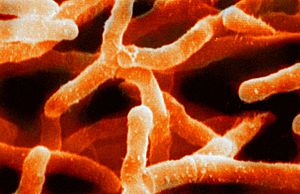Actinomycetota facts for kids
Quick facts for kids Actinomycetota |
|
|---|---|
 |
|
| Scanning electron micrograph of Actinomyces israelii. | |
| Scientific classification |
|
| Domain: | Bacteria |
| (unranked): | Terrabacteria |
| Phylum: | Actinomycetota Goodfellow 2021 |
| Type genus | |
| Actinomyces Harz 1877 (Approved Lists 1980)
|
|
| Classes | |
|
|
| Synonyms | |
|
|
The Actinomycetota (also called Actinobacteria) are a large group of bacteria. They are known as gram-positive bacteria because of how they look under a microscope after a special test. These bacteria can be found almost everywhere, both on land and in water.
Actinomycetota are very important for our planet. They play a big role in agriculture and forests. This is because they help keep soil healthy. They break down dead plants and animals. This process, called decomposition, turns dead material into nutrients. Plants can then use these nutrients to grow.
Even though fungi also help with decomposition, Actinomycetota are much smaller. They might do their job in slightly different ways. Some Actinomycetota, like Frankia, even live in a special partnership (called symbiosis) with plants. They help plants get nitrogen from the air. In return, the plants give them sugars.
Some types of Actinomycetota, such as many Mycobacterium species, can cause diseases. But others, like Streptomyces, are super helpful. They are a major source of antibiotics, which are medicines that fight bacterial infections.
Contents
What are Actinomycetota?
Actinomycetota are a very diverse group of bacteria. They are one of the most common types of bacteria found. The genus Streptomyces is one of the largest groups of bacteria. These bacteria help keep the soil balanced.
The Bifidobacterium genus of Actinomycetota is very common in the guts of human babies. This group of bacteria is part of the baby's microbiome, which is all the tiny living things in and on our bodies. Even though adults have fewer bifidobacteria, they still help keep the gut healthy.
Some Actinomycetota cells are among the largest and most complex bacteria. But there are also marine (ocean-living) Actinomycetota called Actinomarinales. These are some of the smallest free-living prokaryotic cells. Prokaryotic cells are simple cells that do not have a nucleus.
Scientists have found some Actinomycetota in Siberia and Antarctic ice. They might be the oldest living organisms on Earth. Some have been frozen in permafrost (permanently frozen ground) for about half a million years! Scientists found signs of life by detecting carbon dioxide coming from these ancient samples.
Important Types of Actinomycetota
Most Actinomycetota that are important for medicine or the economy belong to the class Actinomycetia. They are part of an order called Actinomycetales. While some of these can cause diseases in humans, Streptomyces is famous for making antibiotics.
One well-studied Actinomycetota that is not in the Actinomycetales group is Gardnerella. Scientists are still debating how to classify Gardnerella.
Actinomycetota, especially Streptomyces species, produce many useful substances. These are called bioactive metabolites. They help us in medicine by providing:
- Antibiotics (to fight bacteria)
- Antifungals (to fight fungi)
- Antivirals (to fight viruses)
- Medicines for cancer
- Medicines that affect the immune system
They also help in agriculture by providing:
- Insecticides (to kill insects)
- Herbicides (to kill weeds)
- Fungicides (to kill fungi)
- Substances that help plants and animals grow
Some important antibiotics that come from Actinomycetota include aminoglycosides, anthracyclines, chloramphenicol, macrolides, and tetracyclines.
Actinomycetota have a high amount of guanine and cytosine (G+C) in their DNA. This is a way scientists classify them. The G+C content can be as high as 70% in some types.
How Scientists Classify Actinomycetota
Scientists use different ways to group and classify Actinomycetota. They look at their DNA and other features. This helps them understand how different types of Actinomycetota are related to each other.
One way to show these relationships is through a "family tree" or phylogeny. Here are some ways scientists see the family tree of Actinomycetota:
| Whole-genome based phylogeny | 16S rRNA based LTP_12_2021 | GTDB 08-RS214 | ||||||||||||||||||||||||||||||||||||||||||||||||||||||||||||||||||||||||||||||||||||||||||||||||||||||||||||||||||||||||||||||
|---|---|---|---|---|---|---|---|---|---|---|---|---|---|---|---|---|---|---|---|---|---|---|---|---|---|---|---|---|---|---|---|---|---|---|---|---|---|---|---|---|---|---|---|---|---|---|---|---|---|---|---|---|---|---|---|---|---|---|---|---|---|---|---|---|---|---|---|---|---|---|---|---|---|---|---|---|---|---|---|---|---|---|---|---|---|---|---|---|---|---|---|---|---|---|---|---|---|---|---|---|---|---|---|---|---|---|---|---|---|---|---|---|---|---|---|---|---|---|---|---|---|---|---|---|---|---|---|---|
|
|
|
The main way scientists officially name and group bacteria is based on the List of Prokaryotic names with Standing in Nomenclature (LPSN) and the National Center for Biotechnology Information (NCBI). Here are some of the main classes within Actinomycetota:
- Class "Aquicultoria"
- Class "Geothermincolia"
- Class "Humimicrobiia"
- Class Acidimicrobiia
- Class Actinomycetia
- Subclass Actinobacteridae
- Subclass Nitriliruptoridae
- Class Coriobacteriia
- Class Rubrobacteria
- Class Thermoleophilia
See also
 In Spanish: Actinobacterias para niños
In Spanish: Actinobacterias para niños
- List of bacteria genera
- List of bacterial orders
- List of bacterial vaginosis microbiota

